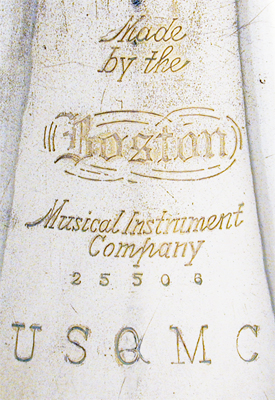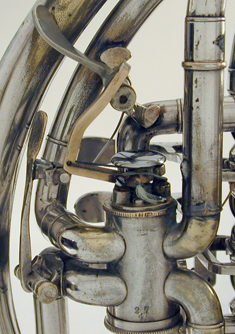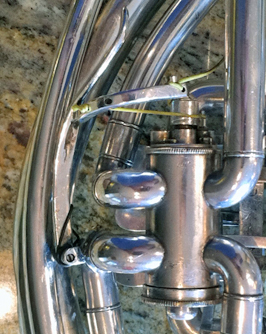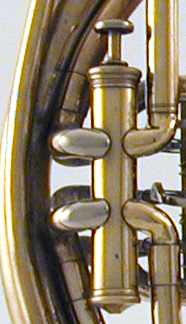| Label :
|
Made by the Boston Musical Instrument Company 25506 U S Q M C |
||||||||||||||||||||||||||||||||||||||||||||||||||||||||||||||||||||||
|
Model:
|
Double horn with rotary change valve |
||||||||||||||||||||||||||||||||||||||||||||||||||||||||||||||||||||||
|
Serial Number:
|
25506 |
||||||||||||||||||||||||||||||||||||||||||||||||||||||||||||||||||||||
|
Date of Manufacture:
|
ca. 1925 - 1928 based on serial number | ||||||||||||||||||||||||||||||||||||||||||||||||||||||||||||||||||||||
|
Key(s):
|
F and Bb |
||||||||||||||||||||||||||||||||||||||||||||||||||||||||||||||||||||||
|
Valves:
|
4 rotary |
||||||||||||||||||||||||||||||||||||||||||||||||||||||||||||||||||||||
|
Bore:
|
11.75 |
||||||||||||||||||||||||||||||||||||||||||||||||||||||||||||||||||||||
|
Bell Flare:
|
[no seams observed due to plating] |
||||||||||||||||||||||||||||||||||||||||||||||||||||||||||||||||||||||
|
Bell Throat:
|
7.0 cm |
||||||||||||||||||||||||||||||||||||||||||||||||||||||||||||||||||||||
|
Bell Diameter:
|
30.5 cm |
||||||||||||||||||||||||||||||||||||||||||||||||||||||||||||||||||||||
|
Base Metal:
|
Yellow Brass |
||||||||||||||||||||||||||||||||||||||||||||||||||||||||||||||||||||||
|
Finish:
|
Silver plated |
||||||||||||||||||||||||||||||||||||||||||||||||||||||||||||||||||||||
| . (click on photos for larger view) |
|||||||||||||||||||||||||||||||||||||||||||||||||||||||||||||||||||||||
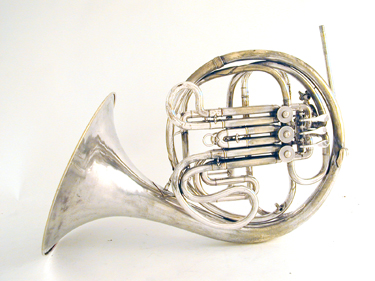 |
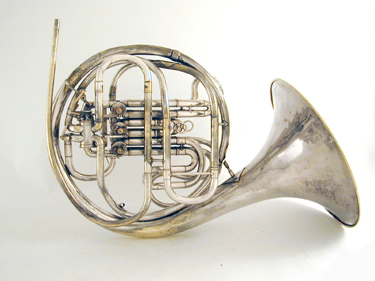 |
||||||||||||||||||||||||||||||||||||||||||||||||||||||||||||||||||||||
The horn shown above is the only known model of a double horn offered by the Boston Musical Instrument Company. The wrap is the same as the very popular C.F. Schmidt model double horn however the change valve operated by the player’s thumb is a rotary valve, whereas the distinctive feature of the original C.F. Schmidt design dating from 1900 was its Périnet piston change valve (see below). The change valve on this horn follows a utility patent (D.R.G.M. 182267) by Firma Ed. Kruspe from 1902 where the rotor is pushed horizontally. An example of the Kruspe horn is found in the collection of the Musikwisssenschlaftilishes Institute of Eberhard Karls Universität Tübingen. |
|||||||||||||||||||||||||||||||||||||||||||||||||||||||||||||||||||||||
|
|||||||||||||||||||||||||||||||||||||||||||||||||||||||||||||||||||||||
|
|||||||||||||||||||||||||||||||||||||||||||||||||||||||||||||||||||||||
 |
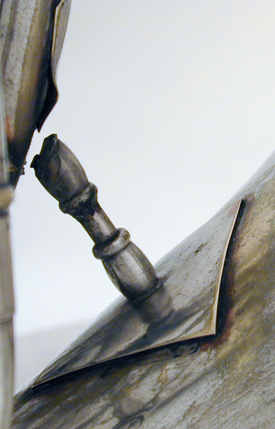 |
||||||||||||||||||||||||||||||||||||||||||||||||||||||||||||||||||||||
|
Some
Boston Musical Instrument Company Instruments
Supplied to the U.S. Quartermaster Department / Corps6
|
|||||||||||||||||||||||||||||||||||||||||||||||||||||||||||||||||||||||
